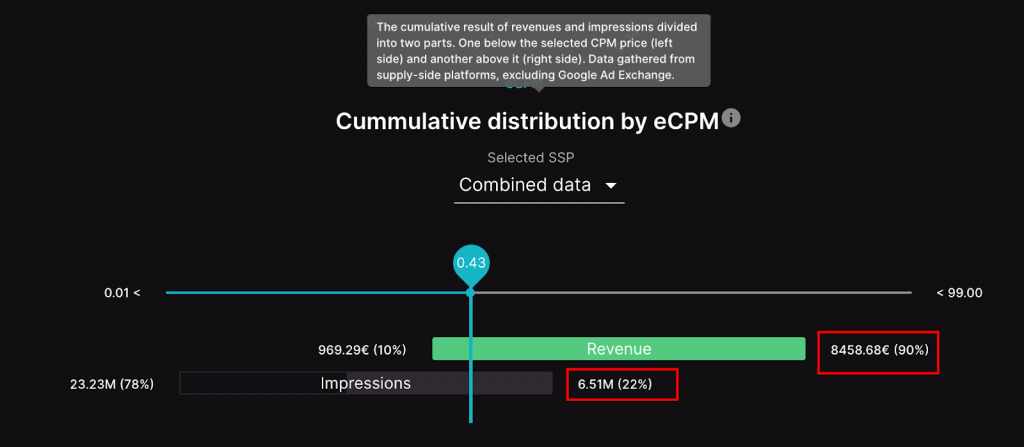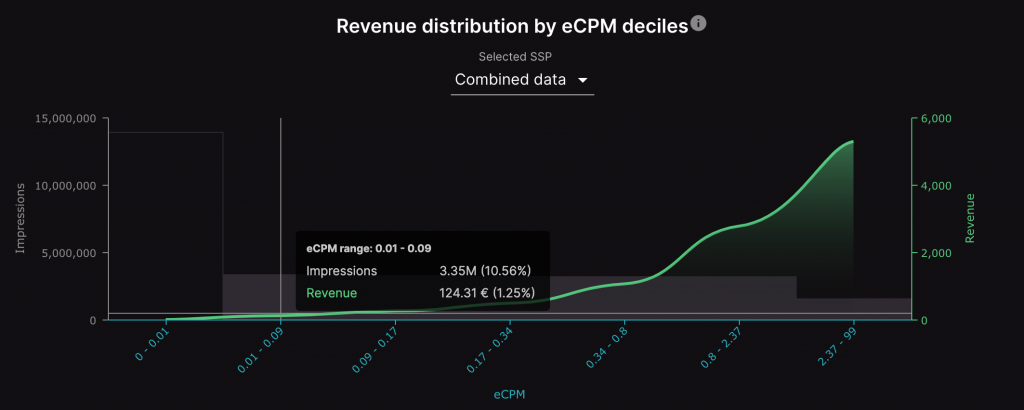3 Tips for Price Floor Optimization in Programmatic
In our previous article, we explained the difference between first-price and second-price auction. Since Google Ad Manager has completely switched to the first-price auction model, there seems to be a lot less conversation about price floor optimization.
In our view, price floors (or floor prices) may be more important than ever. In the first-price auction, advertisers will be trying to optimize their budgets to get impressions at the lowest possible price. So you still need to make sure you’re getting a fair value for your inventory, which is achieved by careful price floor management.
So, what is a price floor, and how to optimize it?
What is a Price Floor?
A price floor is a fixed CPM price that acts as a threshold from which the bids are allowed to participate in the auction. In other words, a price floor prevents advertisers from buying ad impressions at prices below a certain amount set by the publisher or monetization partner.
Note that if publishers don’t utilize price floors, ad inventory‘s value may significantly decrease over time. Bid shading (tactic buyers use to purchase ad impressions at the lowest possible price) hurts publishers’ bottom line a lot. And most importantly, a price floor is necessary to avoid low-quality ads on the publisher’s site that can affect user experience.
Impact Of Price Floor
To better understand the impact of a price floor, we took one of our publisher’s data from Setupad Client UI to show you an example.
Cumulative distribution by eCPM shows how many impressions were sold below and above the selected price and the ad revenue generated.
In the example below, we can see that the average eCPM is 0.43€. 22% (6.51M) of the total ad impressions are sold above the average eCPM price, which attributes to 90% (8458.68€) of the total ad revenue. On the contrary, 78%(23.23M) of the total ad impressions are sold below the average price, which attributes to 10% (969.29€) of the total ad revenue. Therefore, 22% of the total ad impressions generate 90% of the total ad revenue for this publisher.

We at Setupad suggest setting your price floors around 0.01€ to catch all valuable bids. However, price floors up to 0.05€ are considered appropriate.
Revenue distribution by eCPM deciles shows how much ad revenue the publisher has made in a particular eCPM price range. As you can see from the example below, 124.31€ (1.25% of the total ad revenue) for this publisher was generated in eCPM price range of 0.01-0.09€. In this case, we would advise setting a price floor that falls in the middle of the given eCPM range (≈0.05€) and evaluate results based on changes.

Why aren’t high price floors equal to high revenue?
Publishers sometimes believe having higher CPMs will result in higher revenue. They try to achieve this by setting very high price floors. However, this is not usually the case.
For example, if you’ve set the price floor to 1€ CPM, you have increased the average eCPM way above 1€, but in the end, you will not be able to achieve the maximum ad revenue because part of your inventory will be unsold. Therefore, your fill rate will also drop because you’re cutting off all bids below 1€ CPM.
Remember, as you increase your price floor, the demand for your inventory drops. So, the trick is not choosing the highest CPM but finding a sweet spot where you make the most revenue with the highest yield possible.
Related Article: How to Increase Ad Revenue | Success Formula and Proven Solutions
3 Tips for Price Floor Optimization
Price floors, today, can be set up in many different ways–based on geographical locations, device types, and even individual ad units.
1. Try Dynamic Price Floors
Dynamic price floors take into account historical bid data of demand partners and adjust price floors automatically. For example, a publisher regularly sells 1000 ad impressions at 3€ and has a price floor of 1€.
Now, the advertiser who regularly bids with a CPM of 3€ decides to change the strategy and bid with a CPM of 1€. A regular price floor would not adjust, and the ad would be sold at a CPM of 1€. Dynamic price floors would consider the advertiser’s bid history and set a price floor to 2€, so the advertiser will be pushed to bid a minimum CPM of 2€, earning the publisher an extra 1€ for every 1000 ad impressions.
Today, many SSPs and price floor optimization partners have developed their own dynamic price floor technologies to protect publishers’ value. For example, Magnite’s (formerly Rubicon Project) machine learning algorithms allow publishers to choose a price range for segments of their inventory, and the price floor will be selected automatically.
Why should you choose dynamic price floors?
The reason dynamic price floors are better than hard price floors (a fixed price floor that discards bids below a certain CPM price) is that many factors influence the market. For example, prices on weekends might be different from prices on weekdays. Therefore, an algorithm that adjusts price floors automatically can extract the maximum yield for the publisher.
Note, similar technologies exist on the buyers’ side too, which help advertisers make decisions on an impression-by-impression basis. So, publishers still need to keep an eye on their price floor values.
2. Segment Your Ad Inventory
Different ad units require different price floor strategies. High-viewability placements such as billboard and sidebar ad units are a good example when high price floor might be justifiable.
Demands also vary based on countries and regions, so make sure you segment line items by geographic location, especially if most of your traffic comes from one country.
Bid Landscape Report in Google Ad Manager used to be a good solution for publishers to check the impact of their price floors and optimize different inventory segments. However, Google deprecated the feature in 2019, and it’s now only available in GAM 360 (paid version) in the Data Transfer Report. Nonetheless, you can still get good insights if you filter out the fill rate metric on different line item types.
A good approach would be finding the right floor price in order to achieve the desired target average CPM price. Setupad reporting system allows to see and predict how the impressions would be distributed across the CPM price levels. Email [email protected] or reach out to your Account Manager for more information.
3. Experiment with Your Current Price Floor Strategy
It may be useful to experiment with price floors and adjust them now and then. You need to evaluate your bid ranges and decide how you want to optimize your price floors.
Strategy 1: Increase price floors
For example, your strategy might include getting rid of low-paying buyers who are not bringing much revenue while making the existing buyers pay more. Usually, ads below 0.01€ are also low-quality ads. Thus, by cutting them off, you will give your users a better experience and increase your income in the long run.
Strategy 2: Reduce price floors
Another good strategy is to reduce your price floors from time to time to let the demand partners discover your inventory. Advertisers might not be willing to bid higher prices unless they know the true value of your inventory. Temporary price floor reduction might result in more advertisers bidding higher prices once you lift the price floor back.
In Conclusion
Regardless of the changes you make, you always need to monitor the progress. The market changes every minute, so it’s important to quickly adjust your strategy if needed. However, keep in mind that it’s a lot harder for A/B testing to have an effect with first-price auctions. Price floors require a lot of time and attention. So, take a deep breath and prepare to optimize your price floors, or join Setupad and let us take care of it!



